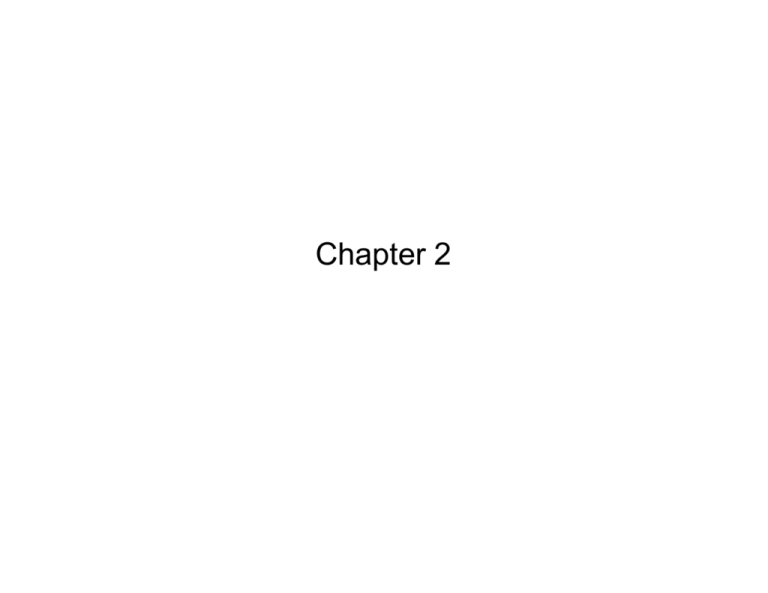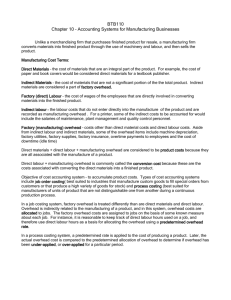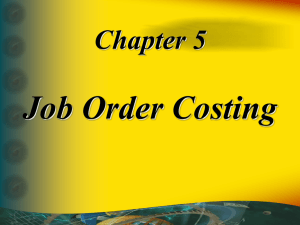Chapter 2
advertisement

Chapter 2 1. Which of the following would be considered a product cost for external financial reporting purposes? a. b. Cost of a warehouse used to store finished goods. Cost of guided public tours through the company's facilities. c. Cost of travel necessary to sell the manufactured product. d. Cost of sand spread on the factory floor to absorb oil from manufacturing machines. 1. Which of the following would be considered a product cost for external financial reporting purposes? a. b. c. Cost of a warehouse used to store finished goods. Cost of guided public tours through the company's facilities. Cost of travel necessary to sell the manufactured product. d. Cost of sand spread on the factory floor to absorb oil from manufacturing machines. Cost of goods manufactured 2. Beginning work in process was $125,000. Manufacturing costs incurred for the month were $835,000. There were $200,000 of partially finished goods remaining in work in process inventory at the end of the month. What was the cost of goods manufactured during the month? a. b. c. d. $1,160,000 $ 910,000 $ 760,000 $ 730,000 Cost of goods manufactured 2. Beginning work in process was $125,000. Manufacturing costs incurred for the month were $835,000. There were $200,000 of partially finished goods remaining in work in process inventory at the end of the month. What was the cost of goods manufactured during the month? a. b. c. d. $1,160,000 $ 910,000 $ 760,000 $ 730,000 Cost Behaviour 3. Last month, when 10,000 units of a product were manufactured, the average cost per unit was $60. At this level of activity, variable costs are 50% of total unit costs. If 10,500 units are manufactured next month and cost behavior patterns remain unchanged, how will costs be affected? A) Total variable costs will remain unchanged. B) Fixed costs will increase in total. C) Variable cost per unit will increase. D) Total cost per unit will decrease. Cost Behaviour 3. Last month, when 10,000 units of a product were manufactured, the average cost per unit was $60. At this level of activity, variable costs are 50% of total unit costs. If 10,500 units are manufactured next month and cost behavior patterns remain unchanged, how will costs be affected? A) Total variable costs will remain unchanged. B) Fixed costs will increase in total. C) Variable cost per unit will increase. D) Total cost per unit will decrease. Chapter 3 Self-test #1 1. Which of the following companies is most likely to use a job-order costing system rather than a process costing system? A)Fast food restaurant B)Shipbuilder C)Crude oil refinery D)Candy maker Self-test #1 1. Which of the following companies is most likely to use a job-order costing system rather than a process costing system? A)Fast food restaurant B)Shipbuilder C)Crude oil refinery D)Candy maker Self-test #2 2.Which of the following statements about labour time and cost in a job-order costing system is NOT correct? – A)Time tickets are kept by employees showing the amount of work on specific jobs. – B)The job cost sheet for a job contains all direct labour charges to that particular job. – C)Labour cost that can be traced to a job only with a great deal of effort is treated as part of manufacturing overhead. – D)A machine operator performing routine annual maintenance work on a piece of equipment charges the maintenance time to a specific job. Self-test #2 2.Which of the following statements about labour time and cost in a job-order costing system is NOT correct? – A)Time tickets are kept by employees showing the amount of work on specific jobs. – B)The job cost sheet for a job contains all direct labour charges to that particular job. – C)Labour cost that can be traced to a job only with a great deal of effort is treated as part of manufacturing overhead. – D)A machine operator performing routine annual maintenance work on a piece of equipment charges the maintenance time to a specific job. Self-test #3 3.In a job-order costing system, when a job remains incomplete at the end of a period, how is the amount of overhead cost that has been applied to that job treated? A)It is deducted on the Income Statement overapplied overhead. B)It is closed out to Cost of Goods Sold. C)It is transferred to Finished Goods. D)It is part of the ending balance of the in Process inventory account as Work Self-test #3 3.In a job-order costing system, when a job remains incomplete at the end of a period, how is the amount of overhead cost that has been applied to that job treated? A)It is deducted on the Income Statement overapplied overhead. B)It is closed out to Cost of Goods Sold. C)It is transferred to Finished Goods. D)It is part of the ending balance of the Work in Process inventory account as 4.Lucy Sportswear manufactures a specialty line of T-shirts. The company uses a job-order costing system. During March, the following costs were incurred on Job ICU2: Direct materials: $13,700 Direct labour: $4,800 In addition, selling and shipping costs of $7,000 were incurred on the job. Manufacturing overhead was applied at the rate of $25 per machine hour, and Job ICU2 required 800 machine hours. If Job ICU2 consisted of 7,000 shirts, what was the Cost of Goods Sold per shirt? A)$5.50. B)$5.70. C)$6.00. D)$6.50. 4.Lucy Sportswear manufactures a specialty line of T-shirts. The company uses a job-order costing system. During March, the following costs were incurred on Job ICU2: Direct materials: $13,700 Direct labour: $4,800 In addition, selling and shipping costs of $7,000 were incurred on the job. Manufacturing overhead was applied at the rate of $25 per machine hour, and Job ICU2 required 800 machine hours. If Job ICU2 consisted of 7,000 shirts, what was the Cost of Goods Sold per shirt? A)$5.50. B)$5.70. C)$6.00. D)$6.50. Self-test #5 5. For the current year, Paxman Company incurred $150,000 in actual manufacturing overhead cost. The Manufacturing Overhead account showed that overhead was overapplied in the amount of $6,000 for the year. If the predetermined overhead rate was $8.00 per direct labour hour, how many hours were worked during the year? A)17,750 hours. B)18,000 hours. C)18,750 hours. D)19,500 hours. Self-test #5 5. For the current year, Paxman Company incurred $150,000 in actual manufacturing overhead cost. The Manufacturing Overhead account showed that overhead was overapplied in the amount of $6,000 for the year. If the predetermined overhead rate was $8.00 per direct labour hour, how many hours were worked during the year? A)17,750 hours. B)18,000 hours. C)18,750 hours. D)19,500 hours. Self-test #6 6. Harrell Company uses a predetermined overhead rate based on direct labour hours to apply manufacturing overhead to jobs. At the beginning of the year, the company estimated its total manufacturing overhead cost at $400,000 and its direct labour hours at 100,000 hours. The actual overhead cost incurred during the year was $350,000 and the actual direct labour hours incurred on jobs during the year was 90,000 hours. By how much is overhead under or over applied for the year? A)$10,000 underapplied. B)$10,000 overapplied. C)$50,000 underapplied. D)$50,000 overapplied. Self-test #6 6. Harrell Company uses a predetermined overhead rate based on direct labour hours to apply manufacturing overhead to jobs. At the beginning of the year, the company estimated its total manufacturing overhead cost at $400,000 and its direct labour hours at 100,000 hours. The actual overhead cost incurred during the year was $350,000 and the actual direct labour hours incurred on jobs during the year was 90,000 hours. What would be the manufacturing overhead for the year? A)$10,000 underapplied. B)$10,000 overapplied. C)$50,000 underapplied. D)$50,000 overapplied. Self-test #7 7. Which of the following suggests the need for multiple departmental overhead rates: A. A highly automated production process. B. The majority of overhead is incurred in one department. C. Significant overhead costs in several departments, each with a unique cost driver. D. The company produces two products each requiring very similar production processes. Self-test #7 7. Which of the following suggests the need for multiple predetermined overhead rates: A. A highly automated production process. B. The majority of overhead is incurred in one department. C. Significant overhead costs in several departments, each with a unique cost driver. D. The company produces two products each requiring very similar production processes. Chapter 4 1.Jawson Company uses the weighted-average method in its process costing system. Operating data for the Painting Department for the month of April appear below: What were the equivalent units of production for conversion costs in the Painting Department for April? A)67,300 units. B)68,820 units. C)70,520 units. D)63,900 units. 1.Jawson Company uses the weighted-average method in its process costing system. Operating data for the Painting Department for the month of April appear below: What were the equivalent units of production for conversion costs in the Painting Department for April? A)67,300 units. B)68,820 units. C)70,520 units. D)63,900 units. 2.Black Company uses the weighted-average method in its process costing system. The company's ending work-in-process inventory consists of 5,000 units, 80% complete with respect to materials and 50% complete with respect to labour and overhead. If the total dollar value of the ending inventory is $60,000 and the cost per equivalent unit for labour and overhead is $8.00, what is the cost per equivalent unit for materials? A)$5.00. B)$10.00. C)$8.00. D)$4.00. 2.Black Company uses the weighted-average method in its process costing system. The company's ending work-in-process inventory consists of 5,000 units, 80% complete with respect to materials and 50% complete with respect to labour and overhead. If the total dollar value of the ending inventory is $60,000 and the cost per equivalent unit for labour and overhead is $8.00, what is the cost per equivalent unit for materials? A)$5.00. B)$10.00. C)$8.00. D)$4.00. 3.Department 2 is the second of three sequential processes. All materials are added at the beginning of processing in Department 2. During October, Department 2 reported the following data: The company uses the weighted-average method in its process costing system. To the nearest cent, what is the cost per equivalent unit on the production report for conversion costs? A)$5.51. B)$6.45. C)$6.30. D)$7.38. 3. Department 2 is the second of three sequential processes. All materials are added at the beginning of processing in Department 2. During October, Department 2 reported the following data: The company uses the weighted-average method in its process costing system. To the nearest cent, what is the cost per equivalent unit on the production report for conversion costs? A)$5.51. B)$6.45. C)$6.30. D)$7.38. 4.Valley Manufacturing Company's beginning work-in-process inventory consisted of 10,000 units, 100% complete with respect to materials cost and 40% complete with respect to conversion costs. The total cost in the beginning inventory was $30,000. During the month, 50,000 units were transferred out. The equivalent unit cost was computed to be $2.00 for materials and $3.70 for conversion costs under the weighted-average method. Given this information, what was the total cost of the units completed and transferred out? A)$255,000. B)$270,000. C)$240,000. D)$285,000. 4.Valley Manufacturing Company's beginning work-in-process inventory consisted of 10,000 units, 100% complete with respect to materials cost and 40% complete with respect to conversion costs. The total cost in the beginning inventory was $30,000. During the month, 50,000 units were transferred out. The equivalent unit cost was computed to be $2.00 for materials and $3.70 for conversion costs under the weighted-average method. Given this information, what was the total cost of the units completed and transferred out? A)$255,000. B)$270,000. C)$240,000. D)$285,000. Chapter 8 1. Why may departmental overhead rates NOT correctly assign overhead costs? A) Because of the potential use of machine hours in allocating overhead costs to products rather than direct labour hours or direct labour cost. B) Because of the high correlation between direct labour hours and the incurrence of overhead costs. C) Because of the over-reliance on volume as a basis for allocating overhead costs where products differ regarding the number of units produced, batch size, or complexity of production. D) Because of the difficulties associated with identifying cost pools for the first stage of the allocation process. 1. Why may departmental overhead rates NOT correctly assign overhead costs? A) Because of the potential use of machine hours in allocating overhead costs to products rather than direct labour hours or direct labour cost. B) Because of the high correlation between direct labour hours and the incurrence of overhead costs. C) Because of the over-reliance on volume as a basis for allocating overhead costs where products differ regarding the number of units produced, batch size, or complexity of production. D) Because of the difficulties associated with identifying cost pools for the first stage of the allocation process. 2. A company inspects 10 finished units in every production run, regardless of how many units are produced in that run. What kind of activity is this? • • • • A) B) C) D) unit-level activity. batch-level activity. product-level activity customer-level activity 2. A company inspects 10 finished units in every production run, regardless of how many units are produced in that run. What kind of activity is this? • • • • A) B) C) D) unit-level activity. batch-level activity. product-level activity customer-level activity 3. Which of the following is least likely to be classified as an organization sustaining activity in an activity based costing system? A) B) plant maintenance property taxes C) machine processing costs D)plant depreciation 3. Which of the following is least likely to be classified as an organization sustaining activity in an activity based costing system? A) B) plant maintenance property taxes C) machine processing costs D)plant depreciation 4. When selecting a cost driver, which of the following should be considered: A) the correlation between the cost driver and overhead costs. B) the total amount of the overhead costs C) the potential effects of selecting a particular cost driver on managers’ behavior. D) Both A & C 4. When selecting a cost driver, which of the following should be considered: A) the correlation between the cost driver and overhead costs. B) the total amount of the overhead costs C) the potential effects of selecting a particular cost driver on managers’ behavior. D) Both A & C 5. Dundas Company uses an activity-based costing system. Consider the following information: Manufacturing Activity Area Machine set -up Material handling Milling Assembly Cost Driver Used As Application Base Number of set-ups Number of parts Machine hours Direct labour hours Conversion Cost per Unit of Application Base $100 5 40 20 During the past month, 40 units of a component were produced. Two set-ups were required. Each unit needs 25 parts, 3 direct labour hours and 5 machine hours. Direct materials costs $125 per finished unit. All other costs are classified as conversion costs. The total manufacturing cost per unit of the component is: A) $139.63. B) $290.00. C) $390.00. D) $515.00. E) $710.00. 5. Dundas Company uses an activity-based costing system. Consider the following information: Manufacturing Activity Area Machine set -up Material handling Milling Assembly Cost Driver Used As Application Base Number of set-ups Number of parts Machine hours Direct labour hours Conversion Cost per Unit of Application Base $100 5 40 20 During the past month, 40 units of a component were produced. Two set-ups were required. Each unit needs 25 parts, 3 direct labour hours and 5 machine hours. Direct materials costs $125 per finished unit. All other costs are classified as conversion costs. The total manufacturing cost per unit of the component is: A) $139.63. B) $290.00. C) $390.00. D) $515.00. E) $710.00. 6. Which of the following statements is false? A) A traditional volume-based system based using direct labor hours as the driver generally overcosts high volume product lines. B) A traditional volume-based system using direct labor hours as the driver generally distorts product costs. C) In a traditional volume-based costing system based on direct labor, high-volume products generally subsidize low-volume products. D) An activity-based costing system generally undercosts low-volume, complex product lines. 6. Which of the following statements is false? A) A traditional volume-based system based using direct labor hours as the driver generally overcosts high volume product lines. B) A traditional volume-based system using direct labor hours as the driver generally distorts product costs. C) In a traditional volume-based costing system based on direct labor, high-volume products generally subsidize low-volume products. D) An activity-based costing system generally undercosts low-volume, complex product lines. 7. Consider the following statements concerning activity-based management (ABM) and ABC: I) ABM complements ABC. II) ABM is an alternative to ABC. III) ABM is incompatible with ABC. A) B) C) D) I is true. II is true. III is true. I and II are true. 7. Consider the following statements concerning activity-based management (ABM) and ABC: I) ABM complements ABC. II) ABM is an alternative to ABC. III) ABM is incompatible with ABC. A) B) C) D) I is true. II is true. III is true. I and II are true.







